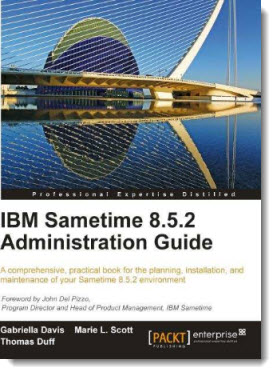PACKT Publishing: IBM Sametime 8.5.2 Administration Guide
 It took me a while to go thru all of the content, but inally I made it and here is my review.
It took me a while to go thru all of the content, but inally I made it and here is my review.
“IBM Sametime 8.5.2 Administration Guide” was written by Gabriella Davis, Marie L. Scott and Thomas “Duffbert” Duff.
I have attended sessions by Gabriella Davis and Thomas Duff at several conferences and while reading the book, I sometimes felt like sitting in the audience and hear Gabriella and Tom talking. I never had the chance to meet Marie L. Scott but I’m sure that she is as enthusiastic as the other authors.
All of them have a deep knowledge and so is the content of the book.
Every detail of the installation and administration is covered and one should be able to setup a Sametime environment following the description in the book step by step. If I only had this book a year ago, it would have saved me a lot of time then.
My first installation took me more than a week. One week with reading documentation, hanging around in forums and chatting with IBMer Frank Altenburg. And a lot of try and error.
Be asured that, following the book, you can do the installation in less time.
Also, if you are new to Websphere, this book is for you. IBM Sametime is not as easy to setup as double-click a setup.exe and wait. There are many places to look into and numerous properties that can be set or eaven been set wrong.
You can do it the hard way and find out on your own, or invest some money buying this book. There will be an immediate ROI.
The book may also help planning the resources by finding out, what exactly is needed, both hardware and soft skills.
I recommend “IBM Sametime 8.5.2 Administration Guide” to everyone who is new to Sametime, wants to upgrade from an older version and even to those, who already have a Sametime 8.5.x environment running. You will for sure find something in the book that is new to you.
















